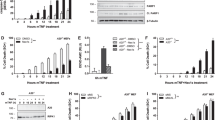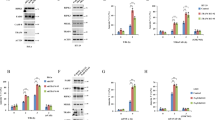Abstract
Tumour necrosis factor-α (TNF-α) is a proinflammatory mediator that exerts its biological functions by binding two TNF receptors (TNF-RI and TNF-RII), which initiate biological responses by interacting with adaptor and signalling proteins. Among the signalling components that associate with TNF receptors are members of the TNF-R-associated factor (TRAF) family1,2. TRAF2 is required for TNF-α-mediated activation of c-Jun N-terminal kinase (JNK), contributes to activation of NF-κB, and mediates anti-apoptotic signals3, 4. TNF-RI and TNF-RII signalling complexes also contain the anti-apoptotic (‘inhibitor of apoptosis’) molecules c-IAP1 and c-IAP2 (refs 5, 6), which also have RING domain-dependent ubiquitin protein ligase (E3) activity7. The function of IAPs in TNF-R signalling is unknown. Here we show that binding of TNF-α to TNF-RII induces ubiquitination and proteasomal degradation of TRAF2. Although c-IAP1 bound TRAF2 and TRAF1 in vitro, it ubiquitinated only TRAF2. Expression of wild-type c-IAP1, but not an E3-defective mutant, resulted in TRAF2 ubiquitination and degradation. Moreover, E3-defective c-IAP1 prevented TNF-α-induced TRAF2 degradation and inhibited apoptosis. These findings identify a physiologic role for c-IAP1 and define a mechanism by which TNF-RII-regulated ubiquitin protein ligase activity can potentiate TNF-induced apoptosis.
This is a preview of subscription content, access via your institution
Access options
Subscribe to this journal
Receive 51 print issues and online access
$199.00 per year
only $3.90 per issue
Buy this article
- Purchase on Springer Link
- Instant access to full article PDF
Prices may be subject to local taxes which are calculated during checkout





Similar content being viewed by others
References
Rothe, M., Pan, M. G., Henzel, W. J., Ayres, T. M. & Goeddel, D. V. The TNFR2-TRAF signaling complex contains two novel proteins related to baculoviral inhibitor of apoptosis proteins. Cell 83, 1243–1252 (1995).
Hsu, H., Shu, H. B., Pan, M. G. & Goeddel, D. V. TRADD-TRAF2 and TRADD-FADD interactions define two distinct TNF receptor 1 signal transduction pathways. Cell 84, 299–308 (1996).
Lee, S. Y. et al. TRAF2 is essential for JNK but not NF-κB activation and regulates lymphocyte proliferation and survival. Immunity 7, 703–713 (1997).
Yeh, W. C. et al. Early lethality, functional NF-κB activation, and increased sensitivity to TNF-induced cell death in TRAF2-deficient mice. Immunity 7, 715–725 (1997).
Shu, H. B., Takeuchi, M. & Goeddel, D. V. The tumor necrosis factor receptor 2 signal transducers TRAF2 and c-IAP1 are components of the tumor necrosis factor receptor 1 signaling complex. Proc. Natl Acad. Sci. USA 93, 13973–13978 (1996).
Chan, F. K., Siegel, M. R. & Lenardo, J. M. Signaling by the TNF receptor superfamily and T cell homeostasis. Immunity 13, 419–422 (2000).
Yang, Y., Fang, S., Jensen, J. P., Weissman, A. M. & Ashwell, J. D. Ubiquitin protein ligase activity of IAPs and their degradation in proteasomes in response to apoptotic stimuli. Science 288, 874–877 (2000).
Tschopp, J., Martinon, F. & Hofmann, K. Apoptosis: Silencing the death receptors. Curr. Biol. 9, R381–R384 (1999).
Van Antwerp, D. J., Martin, S. J., Kafri, T., Green, D. R. & Verma, I. M. Suppression of TNF-α-induced apoptosis by NF-κB. Science 274, 787–789 (1996).
Liu, Z. G., Hsu, H., Goeddel, D. V. & Karin, M. Dissection of TNF receptor 1 effector functions: JNK activation is not linked to apoptosis while NF-κB activation prevents cell death. Cell 87, 565–576 (1996).
Deveraux, Q. L. et al. IAPs block apoptotic events induced by caspase-8 and cytochrome c by direct inhibition of distinct caspases. EMBO J. 17, 2215–2223 (1998).
Roy, N., Deveraux, Q. L., Takahashi, R., Salvesen, G. S. & Reed, J. C. The c-IAP-1 and c-IAP-2 proteins are direct inhibitors of specific caspases. EMBO J. 16, 6914–6925 (1997).
Sarin, A., Conan-Cibotti, M. & Henkart, P. A. Cytotoxic effect of TNF and lymphotoxin on T lymphoblasts. J. Immunol. 155, 3716–3718 (1995).
Zheng, L. et al. Induction of apoptosis in mature T cells by tumour necrosis factor. Nature 377, 348–351 (1995).
Duckett, C. S. et al. A conserved family of cellular genes related to the baculovirus iap gene and encoding apoptosis inhibitors. EMBO J. 15, 2685–2694 (1996).
Chan, F. K. & Lenardo, M. J. A crucial role for p80 TNF-R2 in amplifying p60 TNF-R1 apoptosis signals in T lymphocytes. Eur. J. Immunol. 30, 652–660 (2000).
Arch, R. H., Gedrich, R. W. & Thompson, C. B. Translocation of TRAF proteins regulates apoptotic threshold of cells. Biochem. Biophys. Res. Commun. 272, 936–945 (2000).
Huang, H. et al. The inhibitor of apoptosis, cIAP2, functions as a ubiquitin-protein ligase and promotes in vitro ubiquitination of caspases-3 and -7. J. Biol. Chem. 275, 26661–26664 (2000).
Rothe, M., Wong, S. C., Henzel, W. J. & Goeddel, D. V. A novel family of putative signal transducers associated with the cytoplasmic domain of the 75 kDa tumor necrosis factor receptor. Cell 78, 681–692 (1994).
Rothe, M., Sarma, V., Dixit, V. M. & Goeddel, D. V. TRAF2-mediated activation of NF-κB by TNF receptor 2 and CD40. Science 269, 1424–1427 (1995).
Reinhard, C., Shamoon, B., Shyamala, V. & Williams, L. T. Tumor necrosis factor α-induced activation of c-jun N-terminal kinase is mediated by TRAF2. EMBO J. 16, 1080–1092 (1997).
Weiss, T. et al. Enhancement of TNF receptor p60-mediated cytotoxicity by TNF receptor p80: requirement of the TNF receptor-associated factor-2 binding site. J. Immunol. 158, 2398–2404 (1997).
Weiss, T. et al. TNFR80-dependent enhancement of TNFR60-induced cell death is mediated by TNFR-associated factor 2 and is specific for TNFR60. J. Immunol. 161, 3136–3142 (1998).
Erickson, S. L. et al. Decreased sensitivity to tumour-necrosis factor but normal T-cell development in TNF receptor-2-deficient mice. Nature 372, 560–563 (1994).
Clem, R. J. et al. c-IAP1 is cleaved by caspases to produce a pro-apoptotic C-terminal fragment. J. Biol. Chem. 276, 7602–7608 (2000).
Duckett, C. S. & Thompson, C. B. CD30-dependent degradation of TRAF2: implications for negative regulation of TRAF signaling and the control of cell survival. Genes Dev. 11, 2810–2821 (1997).
Brown, K. D., Hostager, B. S. & Bishop, G. A. Differential signaling and tumor necrosis factor receptor-associated factor (traf) degradation mediated by CD40 and the epstein-barr virus oncoprotein latent membrane protein 1 (Imp1). J. Exp. Med. 193, 943–954 (2001).
Peschon, J. J. et al. TNF receptor-deficient mice reveal divergent roles for p55 and p75 in several models of inflammation. J. Immunol. 160, 943–952 (1998).
Lorick, K. L. et al. RING fingers mediate ubiquitin conjugating enzyme (E2)-dependent ubiquitination. Proc. Natl Acad. Sci. USA 96, 11364–11369 (1999).
Memon, S. A., Petrak, D., Moreno, M. B. & Zacharchuk, C. M. A simply assay for examining the effect of transiently expressed genes on programmed cell death. J. Immunol. Methods 180, 15–24 (1995).
Acknowledgements
We are grateful to A. Weissman, C. Duckett, and Z. Liu for provision of reagents and reviews of this manuscript. X.L. is a visiting fellow from Bethune International Hospital, China.
Author information
Authors and Affiliations
Corresponding author
Ethics declarations
Competing interests
The authors declare that they have no competing financial interests
Supplementary information
Rights and permissions
About this article
Cite this article
Li, X., Yang, Y. & Ashwell, J. TNF-RII and c-IAP1 mediate ubiquitination and degradation of TRAF2. Nature 416, 345–347 (2002). https://doi.org/10.1038/416345a
Received:
Accepted:
Issue Date:
DOI: https://doi.org/10.1038/416345a
This article is cited by
-
cIAP1/TRAF2 interplay promotes tumor growth through the activation of STAT3
Oncogene (2023)
-
Anti-apoptotic Splicing Variant of AIMP2 Recover Mutant SOD1-Induced Neuronal Cell Death
Molecular Neurobiology (2023)
-
Diversity of cell death signaling pathways in macrophages upon infection with modified vaccinia virus Ankara (MVA)
Cell Death & Disease (2021)
-
Clonal expansion of large granular lymphocytes in patients with spondyloarthritis and psoriatic arthritis treated with TNFα inhibitors
Rheumatology International (2021)
-
Weighted gene co-expression network analysis identifies RHOH and TRAF1 as key candidate genes for psoriatic arthritis
Clinical Rheumatology (2021)
Comments
By submitting a comment you agree to abide by our Terms and Community Guidelines. If you find something abusive or that does not comply with our terms or guidelines please flag it as inappropriate.



